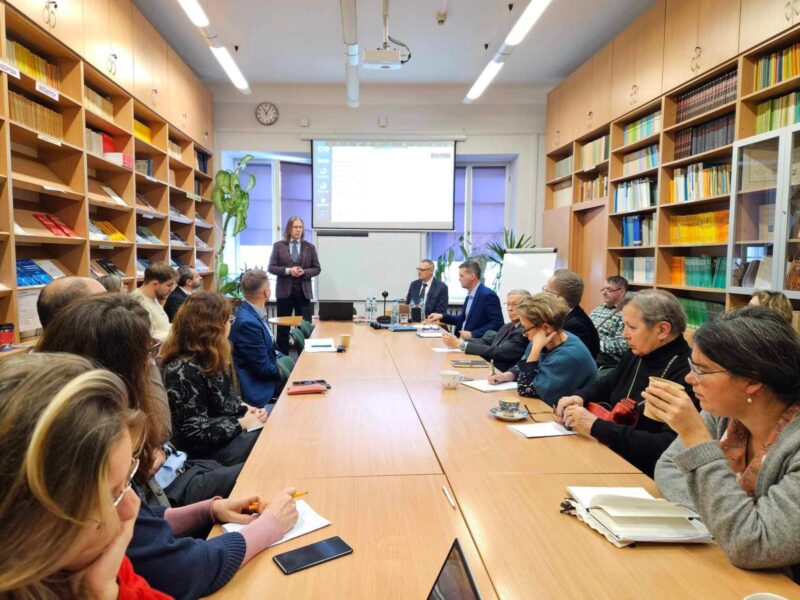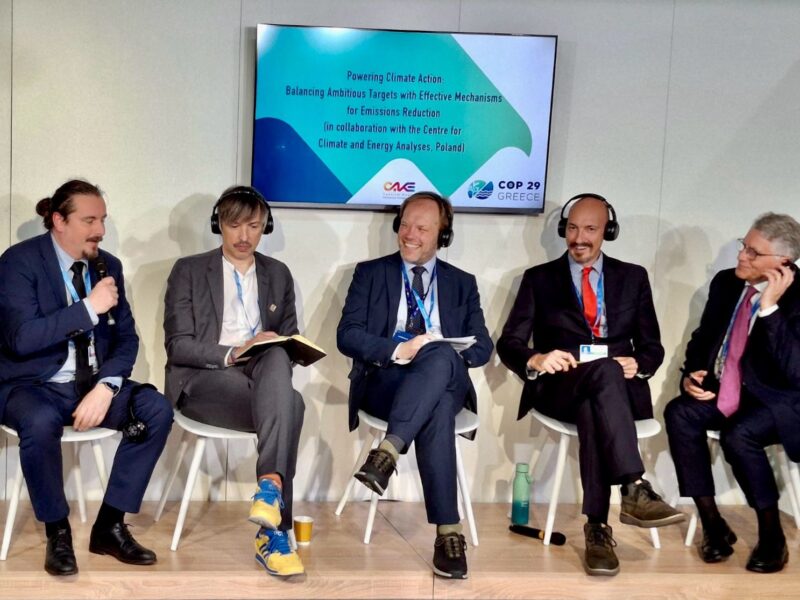
CAKE/KOBIZE attended in a seminar entitled “Impact of climate policy on the agricultural sector in Poland” which was held on December 2, 2024, organized by the Institute of Rural and Agricultural Development of the Polish Academy of Sciences (IRWiR PAN).
CAKE experts on modeling of the agricultural sector, Dr. Adam Wąs and Dr. Paweł Kobus, CAKE/ KOBIZE, presented ways to achieve GHG emission reduction targets in agriculture resulting from the work carried out at KOBIZE under the LIFE Climate CAKE PL and LIFE VIIEW 2050 projects. The EPICA model, built at CAKE to study the effects of reducing GHG emissions in agriculture, was used to prepare the analyses. The analyses presented indicated the potential economic effects of achieving climate neutrality in Polish agriculture in the 2050 perspective.
The results of the analysis indicate that with current production technologies, achieving ambitious reduction targets in agriculture is difficult and leads to a significant reduction in production, and consequently to an increase in the price of agricultural products and an increase in imports of agricultural products. The use of instruments to reduce GHG emissions (CRCF) in agriculture facilitates the achievement of climate policy goals and reduces its negative impact on the income situation of farmers. The choice of methods for achieving the reduction target influences the direction and scale of change in the sector, a mixed option using quota-based emission reductions combined with subsidies for voluntary reductions by farmers appears to be the most favorable alternative. The use of this approach distributes the costs of reduction jointly and severally among all market participants (farmers, taxpayers, consumers).

On the 29th November 2024 CAKE and KOBIZE Experts Jakub Boratyński, Maciej Pyrka, Igor Tatarewicz, Michał Lewarski, Wojciech Rabiega, Adam Wąs and Paweł Kobus participated in the Carbon Pricing Seminar Series – “Exploring interactions between carbon markets and state support for greenhouse gas removals and green hydrogen in the EU context” for the distinguished colleagues from the UK Department for Energy Security and Net Zero.
Maciej Pyrka, Head of the Strategy, Analysis and Auction Unit at KOBIZE/CAKE gave a brief overview of CAKE work, the models and projects in which the CAKE Team is currently engaged.
Jakub Boratyński from CAKE presented the results of the LIFEVIIEW2050 project, co-funded by the EU’s LIFE Programme. His presentation focused on the integration of carbon markets with state support for GHG abatement and green hydrogen in the EU and UK. Using advanced economic and sectoral modelling, he explored how policies such as carbonpricing and subsidies for technologies such as BECCS (bioenergy with carbon capture and storage) and green hydrogen affect the EU’s progress towards climateneutrality by 2050. Boratyński also presented CAKE’s analytical model tools used in the project (e.g. CGE, energy, agriculture, transport models). He explained their functionalities, such as analysing interactions between sectors, projecting emission reductions and assessing the economic impact of different climate policies.
Key findings & main conclusions:
We invite you to check our VIIEW on EU ETS 2050 analyses:
 VIIEW on EU ETS 2050: Linking EU ETS with other carbon pricing mechanisms (3.0 MiB, 314 hits)
VIIEW on EU ETS 2050: Linking EU ETS with other carbon pricing mechanisms (3.0 MiB, 314 hits)
 VIIEW on EU ETS 2050: Exploring synergies between the EU ETS and other EU climate policy measures - carbon removal, hydrogen, and sectoral transport policy (3.3 MiB, 570 hits)
VIIEW on EU ETS 2050: Exploring synergies between the EU ETS and other EU climate policy measures - carbon removal, hydrogen, and sectoral transport policy (3.3 MiB, 570 hits)

On 27-th of November 2024, representatives of KOBIZE/CAKE had the opportunity once again to participate in the next 5th edition of the TECHCO FORUM Conference organized by the Polish Chamber of Chemical Industry in a thematic block devoted to energy transition – regulations, costs and technologies.
Maciej Pyrka, Head of the Strategy, Analysis and Auction Team of KOBIZE/CAKE gave a presentation entitled. “EU ETS Reform after 2030: “Challenges and Opportunities on the Road to Climate Neutrality.” In his presentation, he outlined the current challenges in EU climate policy and regarding the future of the EU ETS, the depletion of the allowance pool by around 2040, possible solutions such as the establishment of a European Central Carbon Bank (ECCB), and presented the latest results of the work and analysis of CAKE and LIFEVIIEW2050.
Robert Jeszke, Deputy Director of IOŚ-PIB, CEO of KOBIZE/CAKE was one of the speakers in the panel discussion: “Regulatory environment in the context of Polish industry determinants: RED III, EUETS, CBAM – challenges, opportunities, forecasts, strategies”. During his speech, he stressed the need to increase the competitiveness of the European Union in the area of new technologies, which are the foundation of a low-carbon economy. He also pointed out the key role of low-cost hydrogen electricity and energy storage, enabling efficient use of surplus production from RES. He pointed out that in the long term, national surpluses of energy from RES can be achieved with the support of nuclear power, which will provide a stable base for the energy system. In addition, he pointed to the need to develop a hydrogen economy, while warning of the risk of dependence on hydrogen imports from outside Europe, which could lead to a repeat of the problems known from the gas sector. He also stressed the importance of CO₂ sequestration technologies, which will help offset the EU’s remaining emissions and possibly reduce costs in the EU ETS (if included in the system), and pointed out that the development of new technologies will require access to rare earth resources. In the context of climate policy, he pointed out that it can become an opportunity to build the competitiveness of EU industry if it focuses on investing in low-carbon and innovative technologies needed for the future. Poland and Europe need to develop innovative industrial sectors, go beyond the patterns and build competitive advantages in key areas.

We are pleased to present the latest report prepared by CAKE/KOBiZE titled “VIIEW on EU ETS 2050: Linking EU ETS with other carbon pricing mechanisms”. The publication was developed as part of the LIFE VIIEW 2050 project and is available in English. The document thoroughly discusses the possibilities and implications of linking the European Union Emissions Trading System (EU ETS) with other global carbon pricing mechanisms, as well as the role of offset mechanisms in achieving international climate goals.
Dowload here:
 VIIEW on EU ETS 2050: Linking EU ETS with other carbon pricing mechanisms (3.0 MiB, 314 hits)
VIIEW on EU ETS 2050: Linking EU ETS with other carbon pricing mechanisms (3.0 MiB, 314 hits)
 The EU ETS plays a key role in achieving the European Union’s climate goals, such as reducing greenhouse gas emissions by 55% by 2030 and achieving climate neutrality by 2050. One of the challenges associated with further development of this system is minimizing the risk of carbon leakage and improving the cost-efficiency of emissions reductions.
The EU ETS plays a key role in achieving the European Union’s climate goals, such as reducing greenhouse gas emissions by 55% by 2030 and achieving climate neutrality by 2050. One of the challenges associated with further development of this system is minimizing the risk of carbon leakage and improving the cost-efficiency of emissions reductions.
In response to these challenges we are pleased to present our latest report prepared by CAKE/KOBiZE titled “VIIEW on EU ETS 2050: Linking EU ETS with other carbon pricing mechanisms”. The publication was developed as part of the LIFE VIIEW 2050 project and is available in English.
Our report examines:
Through macroeconomic analysis, the report assesses how this integration could affect carbon pricing, emissions reductions and economic indicators in different regions. Presented measures aim to improve market stability, mitigate carbon leakage, foster international cooperation, and ensure a cost-effective path toward achieving climate neutrality by 2050.
In the current analysis, we present and analyse baseline scenario and two analytical scenarios reflecting different levels of ETS integration and policy mechanisms. We consider linking the EU ETS with other international ETSs and limited use of offsets in the EU ETS. First scenario explores how linking the EU ETS with systems in other regions could lower emissions reduction costs, stabilize allowance prices, and reduce economic disruptions. The second scenario analyzes the use of offsets sourced from Global South countries within the EU ETS. Such a mechanism could lower compliance costs and support low-carbon development in developing nations.
The analysis was performed using advanced modelling tools developed by CAKE experts. Such an extensive and comprehensive analysis was possible thanks to the implementation of the LIFE VIIEW 2050 project – The impact assessment of the EU Emission Trading System with the long-term vision for a climate neutral economy by 2050 implemented at KOBiZE with the financial support of the LIFE Program and the National Fund for Environmental Protection and Water Management.
This is another in a series of analyses on various aspects of the development of the EU ETS. Other analyses, which cover ETS2, removals, hydrogen or transport policies, among others, can be found here.

On the 18th November 2024 CAKE experts participated on the last event organised by CAKE at COP29 which took place in the Greek Pavilion tittle: “Powering Climate Action: Balancing Ambitious Targets with Effective Mechanisms for Emissions Reduction”.
We invited and were delighted to host:
The discussion, moderated by Maciej Cygler from CAKE, centered on the challenges of developing robust carbon pricing systems and their role in achieving net-zero ambitions. Drawing on insights from the LIFEVIIEW2050 project, he framed the conversation. Mentioning the expected shortage of carbon credits in the EU ETS appeared to be a good starting point for discussing options for the further development of this type of measures. He then went on to ask a series of questions to moderate the interventions of our distinguished speakers.
Kurt Vandenberghe outlined the hurdles of linking emissions trading schemes globally, citing the need for systems to be equivalent in structure and integrity. He reflected on past EU experiences with CERs and emphasized that domestic reductions must remain the priority. Although the idea is theoretically sound, its practical implementation seems unfeasible today. There are too many obstacles to overcome to make it work and be accepted, including not only the economic implications, but most importantly the differences in carbon pricing mechanisms in jurisdictions with such measures. There are only two examples that work – California and Quebec, and the EU ETS and Switzerland. The systems to be coupled should be equivalent in all dimensions, and that is a challenge. However, he highlighted the potential of CBAM and carbon removals in driving global action under Article 6 of the Paris Agreement, while stressing that removals must not replace mitigation efforts.
Gerassimos Thomas underscored the need for predictability in climate policies, crucial for investor confidence. Carbon pricing and CBAM are different sides of the same coin, but at the moment both sides are mainly focused on the most emission and energy intensive sectors, while clean technologies should not feel challenged. Moreover, carbon pricing provide revenues to be invested. If we develop right measures – private sector would engage with investments, technology transfer and capacity building. He advocated for measures that balance carbon pricing and CBAM to ensure they protect clean technologies while incentivizing investments in decarbonization.
Krzysztof Bolesta proposed exploring both “hard” and “soft” linking of ETSs, as well as offset mechanisms, to lower the cost of achieving reductions while fostering international cooperation. He stressed that offsetting could unlock funding and incentivize emission reductions in other jurisdictions.
Simone Borghesi emphasised the inevitable role of removals in achieving ambitious reduction targets in long term, both in the EU and in the world. All the models predicts to include increased role of CDR as the solution – the problem it is not whether, by when and how? Timing would be crucial in this process, however it depends also on social acceptability. As we have a number of different CDR methods, we should carefully consider pros and cons. There is not one good solution. Also integrity issue is important. And finally, removals must not replace mitigation efforts.
Robert Jeszke linked these perspectives to CAKE’s analysis, emphasizing the need for diversity in climate policy tools. He supported removals as essential to the ETS’s future but agreed that linking non-equivalent systems is currently unfeasible. Robert introduced the idea of a European Central Carbon Bank (ECCB) to stabilize the EU ETS, mitigate costs, and support international cooperation under Article 6. Such a bank seems to be a good solution to mitigate costs and price increases resulting from carbon pricing measures, but also to protect mechanisms such as the EU ETS from shocks. Moreover, the bank could help other countries to provide funds, also under Art. 6 of the Paris Agreement. The ETS needs additional flows, which can come from removals and linking the system. However, we should be looking at future solutions, including those that are compatible with global schemes, with Article 6 as a central piece. Today’s most pressing challenges are to reduce emissions, to keep the ETS as the main instrument for reducing emissions, to keep industry in the EU and to save European households.
The event concluded with a shared understanding of the challenges and opportunities in refining carbon pricing mechanisms.